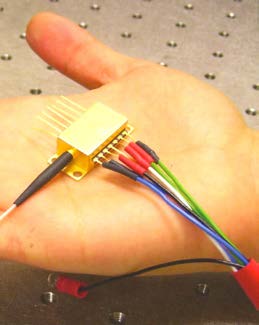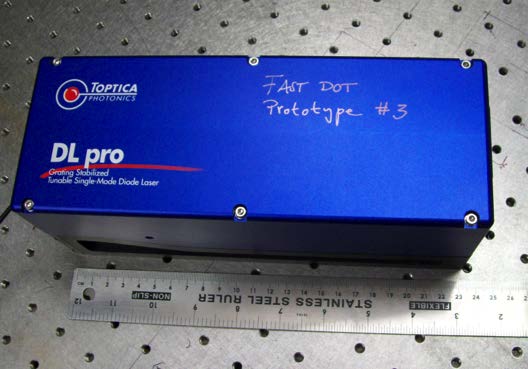Development of compact and efficient laser systems
Submitting Institution
University of DundeeUnit of Assessment
General EngineeringSummary Impact Type
TechnologicalResearch Subject Area(s)
Physical Sciences: Optical Physics, Other Physical Sciences
Chemical Sciences: Physical Chemistry (incl. Structural)
Summary of the impact
This is an example of early economic impact where research on various
aspects of laser engineering has resulted in the development of
inexpensive, compact, efficient and user-friendly laser sources. An
example is the incorporation of quantum dot structures into semiconductor
laser architectures, with these replacing much larger and more expensive
systems, with a range of applications in areas such as microscopy,
biomedical diagnosis and therapy. This work has led to the generation of
key know-how and patents that have been subsequently licensed as well as
resulting in a variety of laser-related products being brought to market.
Additionally, it has resulted in extra staff being employed at one of our
partner companies.
Underpinning research
Since 1987, Professor Edik Rafailov has been engaged in the research and
development of novel semiconductor lasers, nonlinear and integrated
optics. On moving to Dundee in 2005 his group began to get involved with a
number of new projects developing novel laser architectures and
laser-based optical tools. Much of this research was carried out with
industrial partners and these collaborations have led to a number of new
devices being brought to market. This work has primarily been in the area
of compact and efficient laser systems and their applications, underpinned
by funding from a number of sources, especially the EU FP7, EPSRC and KTP
funding (some representative grants are shown in section 3).
One of the major directions has been on cw and ultrafast semiconductor
quantum-dot-based lasers, funded through a €13.7M grant called FASTDOT.
Ultrafast lasers are able to generate light pulses with durations
spanning from a few femtoseconds (fs) to a few picoseconds, with
applications in areas such as non-invasive diagnostics and therapeutic
medicine, micromachining, spectroscopy and imaging (1fs to 1s is the same
as 1s to 32 million years). The currently available ultrafast lasers are
bulky, expensive, difficult to operate and often offer limited flexibility
in how their pulse characteristics can be matched to a specific
application. The Photonics and Nanoscience Group at the University of
Dundee has undertaken a very significant programme of research in
conjunction with many companies (in particular with Innolume GmbH, and M
Squared Lasers) to manufacture and develop low-cost, compact and turn-key
laser sources that can generate ultrashort optical pulses with tailored
characteristics. Such operational characteristics are particularly
critical in the development of novel optical tools for diagnostics and
therapy in the biomedical sciences.
 Figure 1 Compact laser system of the type developed in this case study
Figure 1 Compact laser system of the type developed in this case study
In order to achieve these goals, the Dundee group has focused on a novel
class of materials — semiconductor quantum dots (QDs).
QDs consist of tiny clusters of semiconductor material with dimensions of
only a few nanometers. The unique properties of these materials enable the
manufacture of compact, efficient and environmentally stable semiconductor
lasers.
This work produced a range of new mode-locked and cw laser sources based
around quantum dot technology [1-3], which have enabled a number of
applications in biomedical imaging and therapy, resulting in a patent on
the use of a quantum-dot-based laser for photodynamic therapy [P1]. This
then led to a number of spin off projects, such as the development of
terahertz emitters [4] and devices producing widely tuneable visible light
[5].
Another major research vector on the development of compact and efficient
lasers has been the investigation of an old optical phenomena called
`conical refraction' in which light passing through a biaxial crystal
leads to an output beam with an unusual cone shaped intensity profile and
polarisation properties. This was used to make an incredibly efficient
(close to 99% of the theoretical efficiency) laser [6]. This work led to a
patent [P2], and subsequent KTP funding in collaboration with M Squared
Lasers to further develop the concept to a marketable device.
The work on quantum dot lasers and the collaboration with M Squared
Lasers has also led to the filing of a third patent, which is focused on
the development of novel laser systems based on semiconductor disk and
quantum dot lasers for nonlinear optical microscopy of biological
organisms. The patent is shared between members of the FASTDOT consortium,
including M Squared Lasers.
References to the research
* Denotes key references
1. K.G. Wilcox, M. Butkus, A. Tropper, I. Farrer, D.A. Ritchie, E.U.
Rafailov, "Sub-Picosecond Quantum Dot Saturable Absorber Mode-Locked
Semiconductor Disk Laser", Applied Physics Letters 94, 251105
(2009). DOI: 10.1063/1.3158960
2. M. Butkus, K. G. Wilcox, J. Rautiainen, O. G. Okhotnikov, S. S.
Mikhrin, I. L. Krestnikov, A. R. Kovsh, E. M. Hoffmann, T. Südmeyer, U.
Keller, and E.U. Rafailov, "High-Power Quantum Dot Based
Semiconductor Disk Laser", Optics Letters 34, 1672 (2009).
DOI: 10.1364/OL.34.001672
3. Y. Ding, R. Aviles-Espinosa, M. A. Cataluna, D. Nikitichev, M. Ruiz,
M. Tran, Y. Robert, A. Kapsalis, H. Simos, C. Mesaritakis, T. Xu, P.
Bardella, M. Rossetti, I. Krestnikov, D. Livshits, Ivo Montrosset, D.
Syvridis, M. Krakowski, P. Loza-Alvarez, and E. U. Rafailov "High peak
power picosecond optical pulse generation using a quantum-dot
external-cavity passively mode-locked laser and a quantum-dot optical
amplifier"
Optics Express 20, 14308 (2012). DOI:10.1364/OE.20.014308
4. *T. Kruczek, R. Leyman, D. Carnegie, N. Bazieva, G. Erbert, S. Schulz,
C. Reardon, and E.U. Rafailov, "Continuous wave terahertz
radiation from an InAs/GaAs quantum-dot photomixer device", Applied
Physics Letters 101, 081114-4 (2012). DOI:10.1063/1.4747724
5. *K.A. Fedorova, G.S. Sokolovskii, P.R. Battle, D.A. Livshits, and E.
U. Rafailov, "Green-to-red tunable SHG of a quantum-dot laser in a
PPKTP waveguide", Laser Physics Letters 9, 790 (2012). DOI: 10.7452/lapl.201210085
6. *A. Abdolvand, K.G. Wilcox, T.K. Kalkandjiev, E.U. Rafailov, "Conical
refraction Nd:KGd(WO4)(2) laser," Opt. Express 18 2753 (2010).
DOI:10.1364/OE.18.002753
Underpinning funding:
2008-2012: FP7 IP programme — lead and Coordinator: Compact
ultrafast laser sources based on novel quantum dot structures (FAST DOT) -
18 partners (value €13.7M).
2008-2009: Resonator modes in the presence of passive element for
conical refraction (value €10k) ACCORD Project with Cone-Refringent
Optics, Barcelona.
2010-2013: EPSRC grant (EP/H015795/1): Compact diode-laser-pumped
THz source based on a novel photomixer device." (value £620k).
2011-2014: KTP grant: Development of a novel class high power
laser source based on conical refraction crystal technology (value £195k)
(with M Squared Lasers Ltd.)
Related Patents
P1. Quantum dot laser diode
Patent number: USA - 2013/164452.
P2. Novel photonic devices based on conical refraction
Patent numbers: Europe — EP10708577.1; Canada - 2,750,297; China -
2010800125702; USA - 2013/145736.
Details of the impact
The laser systems developed have largely resulted in an economic impact
based on licensing and sales of the products developed by two of the key
partners in the research grants mentioned above. These companies are a
German diode laser company, Innolume and a UK based laser manufacturer, M
Squared Lasers. This extremely fruitful partnership of the Dundee Group
with these manufacturers has led to a successful economic impact for both
companies and the University over a very short period of time.
Innolume have significantly improved the performance of one of their key
products called the "Gain Chip" thanks to the work carried out with the
Dundee Group. The company estimate that this improved device has led to
approximately €100k in annual income [REFa]. The gain chips are used by
end users in a variety of applications from tuneable lasers [5], narrow
linewidth external cavity diode lasers and in emerging applications using
swept laser sources such as optical coherence tomography.
Additionally the quantum dot research has led to a range of new Innolume
products being developed and the initial income is now starting to build
despite the fact that the research on these topics has largely been
carried out over the period 2008-2012. Innolume's current revenues
(2009-2013) from this research are: €20k from novel ultra short pulse
laser sources; €25k from QD THz antennas designs and €10k from novel
Semiconductor Saturable Absorber Mirror (SESAMs) designs [REFa].
The work with M Squared Lasers has also led to new products being brought
to market [text removed for publication] [REFb]. This work was based on
the research that was developed in the FASTDOT project.
The two patents mentioned in the references section [P1 and P2] have
underpinned the second relationship of the Dundee group, this time with M
Squared Lasers. M Squared Lasers have licensed both patents and are
developing these into new product lines. They have developed a QD laser
from the patent [P1] — the applications ultimately being for end users
looking for compact sources in areas such as photodynamic therapy, and
evolving into multiphoton imaging and microscopy (which has been
demonstrated as viable by the Rafailov group, and patented along with
authors from M Squared Lasers). The income to date (since 2009 when the
license was taken up) is £10k [REFc].
The second license was based around the patent [P2] to be used to develop
a new laser source based around the conical refraction effect. This has
resulted in £16k of income [REFb] since the patent was licensed in 2009,
with further development being funded through a £195k KTP award
(2011-2014) with the company, demonstrating the early impact of this
particular strand of work on highly efficient solid state laser sources.
The relationship between Dundee and M Squared Lasers is significant; this
has been underpinned with two other KTP projects in the last five years,
to work on compact laser sources for near-infrared imaging (KTP 7071) and
THz sources for imaging applications (KTP 7892). The value of this
commercial interaction is substantial. It is the 9th highest
supplier of industry income to the University, lying only behind eight
large pharmaceutical companies. Income in the REF period is £363k, with
£262k of this being in financial year 2012-13.
 Figure 2: Toptica prototype based on work at Dundee
Figure 2: Toptica prototype based on work at Dundee
The interaction between the research at Dundee and M Squared Lasers has
led to the growth of the company and they have employed two extra staff to
help further develop products as a direct result of this work. The company
is a SME with around 40 employees, so these hires are 5% of the total
workforce.
Additionally Toptica (GmbH), another German laser company, has developed
a prototype (figure 2) tuneable QD laser source based on the outcomes of
the research conducted at the University of Dundee, but as yet no device
has been brought to market based on these research outcomes [REFd].
Sources to corroborate the impact
Further information on the company specific involvements can be obtained
from the following sources:
- [REFa] CTO, Innolume GmbH (factual statement).
- [REFb] Business Development Manager, M Squared Lasers Ltd. (factual
statement).
- [REFc] Business Development Manager, Research and Innovation Services,
University of Dundee.
- [REFd] President, Toptica GmbH.